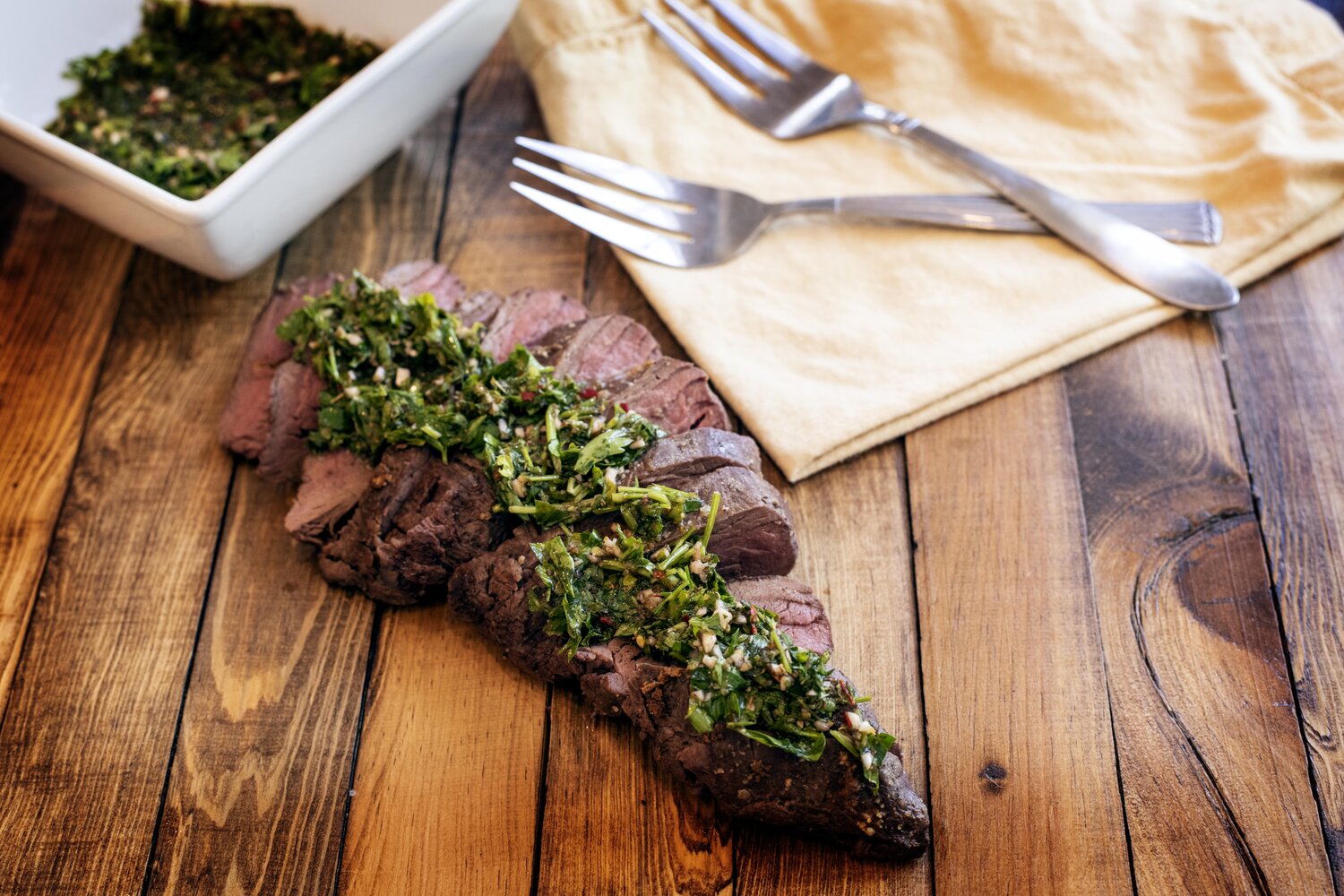I often find myself defending the “gameyness” of wild game, and especially with elk. If you look up the word gamey in the dictionary it says “having the tangy flavor of game, especially game kept uncooked until slightly tainted.” This definition gives the impression that wild game tastes spoiled and maybe even to go so far as to say rotten.
It gets hard sometimes because I feel like I am defending wild game, saying it doesn’t taste “gamey” because gamey implies it tastes bad. Which it doesn’t! But at the same time, it also has a flavor and taste all its own, which sometimes can only be defined as “gamey” because it can’t be described like beef, chicken, or pork.
If we can get on the same page that “gamey” doesn’t mean rotten, I don’t mind embracing this notion that elk is going to provide a “gamey” experience to the diner. Enhancing this unique flavor is all the more fun when creating wild game dishes. It’s about finding ingredients, whether its sauce, spices, herbs, vegetables, fruits, that embolden the “gameyness” of the wild game and create a unique dining experience every time.
Chimichurri is one of those sauces that takes the backbone created by deer or elk in its simplest form, sprinkled with nothing more than salt and pepper, and builds that backbone into a full circle dining experience. And as an added bonus: it is incredibly easy to mix up!
Whipping up Chimichurri
So, what is chimichurri? In its purest form, chimichurri is very simple. It starts with the most basic and common herb I think there is: parsley. The parsley is marinated in garlic, vinegar, olive oil and crushed red pepper flakes. Chimichurri originated in South America, and is especially popular in Argentina, where it is often labeled “Argentina barbecue sauce.” It can be served up several ways, used as a marinade for meat, a base for salads, mixed with condiments for a sandwich starter, and even just set atop a beautiful piece of meat. We are going to use this last option as our final destination with this Elk Tenderloin with Chimichurri dish.
Chimichurri adds a fresh taste to any dish that is hard to replicate with most sauces. Parsley is a very unrated herb. In my mind it is usually just a garnish that gets thrown away at the end of the meal. Chimichurri lets parsley shine!
For this elk tenderloin lunch I kept things very simple and traditional as possible with chimichurri. Chop up the bunch of parsley, about two cups worth, into small, bite size pieces. Add a couple of cloves of garlic, minced, to the parsley. I did four cloves for my chimichurri.
In one bowl, mince up the parsley and garlic cloves.
The chimichurri marinade filled with red wine vinegar, red pepper flakes, salt, pepper, oregano, and olive oil.
And the final product.
In a separate bowl, mix together the chimichurri marinade: start with a quarter cup of red wine vinegar and add a teaspoon of red pepper flakes, salt, and pepper. Whisk in a cup of olive oil. I would go with a higher quality olive oil because you aren’t heating or really doing much to the oil.
To the chimichurri marinade add a couple teaspoons of dried oregano and then pour the mixture over the parsley and garlic mixture. Let things marinade for at least an hour, but you can use the mixture for up to a few weeks and the flavors will only develop more with time. Although, the “freshness” from the parsley will start to dissipate some.
Cooking the Elk Tenderloin
Leave the tenderloin in one big piece to cook. Let it sit for about fifteen to twenty minutes and come to room temperature before cooking. Generously salt and pepper the outside of the tenderloin.
Preheat the oven to 400 degrees.
Heat a large skillet, something that is able to go from stove top to oven, over medium high heat. Once the pan is hot it is time to add the tenderloin. Breathe in that “aha” moment when the steak hits the pan! I love that sound and always take a moment to enjoy that simple little pleasure.
Elk tenderloins can be quite thick, I think this one was between three and four inches, and so I cooked it for six minutes per side in hopes of achieving a medium rare to medium finish on my meat. After both sides have been cooked immediately put the entire pan into the oven for five minutes.
Pull the meat from the oven and allow it to rest on a cutting board for five to ten minutes. This will allow the muscle fibers to relax a little and pull the juices back into the fibers of the meat, resulting in juicy, tender pieces of elk tenderloin.
After resting the meat, slice the tenderloin.
Pour the chimichurri all over the sliced elk tenderloin and dig in!
I hope you enjoy this dish! I found it packed with flavor, a little bit tangy, a little big sweet and salty, and even a little bit “gamey.” Enjoy!
Happy Hunting

Elk Tenderloin with Chimichurri
Ingredients
- 2 cups parsley, chopped
- 4 cloves garlic, minced
- 1/4 cup red wine vinegar
- 1 teaspoon crushed red pepper flakes
- 1 teaspoon salt
- 1 teaspoon pepper
- 3 teaspoons dried oregano
- 1 cup olive oil
- 1 elk tenderloin
- Salt and pepper to taste
Instructions
- Chop the parsley and mince the garlic. Mix together in small bowl.
- In separate bowl whisk together the red wine vinegar, crushed red pepper flakes, salt, and pepper.
- Whisk in the olive oil and then stir in the oregano.
- Pour the marinade over the parsley and garlic mixture. Allow to sit in the fridge for at least one hour and up to overnight.
- To cook your tenderloin, clean the meat of any excess fat (which there might not be any!). Allow the meat to rest at room temperature for fifteen to twenty minutes. Season generously with salt and pepper.
- Preheat the oven to 400 degrees.
- Heat a large skillet over medium high heat. You want a skillet that can go from stove top to oven.
- Once the skillet is preheated, place the meat into the pan. Cook for six minutes per side.
- Place the entire skillet into the oven and cook for five minutes.
- Let the meat rest for ten minutes on a cutting board before slicing.
- Top with the chimichurri and enjoy!









